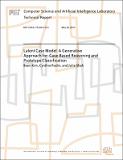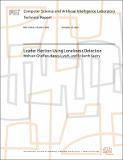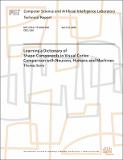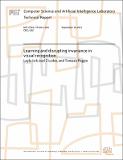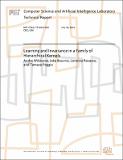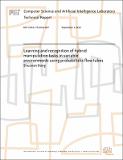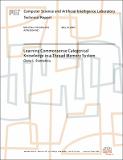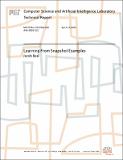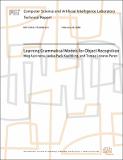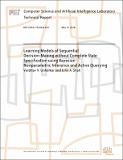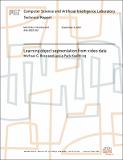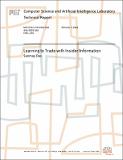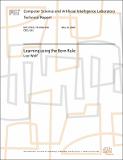Browsing CSAIL Technical Reports (July 1, 2003 - present) by Title
Now showing items 373-392 of 775
-
Latent Case Model: A Generative Approach for Case-Based Reasoning and Prototype Classification
(2014-05-26)We present a general framework for Bayesian case-based reasoning and prototype classification and clustering -- Latent Case Model (LCM). LCM learns the most representative prototype observations of a dataset by performing ... -
Latent-Dynamic Discriminative Models for Continuous Gesture Recognition
(2007-01-07)Many problems in vision involve the prediction of a class label for each frame in an unsegmented sequence. In this paper we develop a discriminative framework for simultaneous sequence segmentation and labeling which can ... -
Leader Election Using Loneliness Detection
(2011-10-12)We consider the problem of leader election (LE) in single-hop radio networks with synchronized time slots for transmitting and receiving messages. We assume that the actual number n of processes is unknown, while the size ... -
LEAP Scratchpads: Automatic Memory and Cache Management for Reconfigurable Logic [Extended Version]
(2010-11-23)Developers accelerating applications on FPGAs or other reconfigurable logic have nothing but raw memory devices in their standard toolkits. Each project typically includes tedious development of single-use memory management. ... -
Learning a Dictionary of Shape-Components in Visual Cortex: Comparison with Neurons, Humans and Machines
(2006-04-25)In this thesis, I describe a quantitative model that accounts for the circuits and computations of the feedforward path of the ventral stream of visual cortex. This model is consistent with a general theory of visual ... -
Learning and disrupting invariance in visual recognition
(2011-09-10)Learning by temporal association rules such as Foldiak's trace rule is an attractive hypothesis that explains the development of invariance in visual recognition. Consistent with these rules, several recent experiments ... -
Learning and Invariance in a Family of Hierarchical Kernels
(2010-07-30)Understanding invariance and discrimination properties of hierarchical models is arguably the key to understanding how and why such models, of which the the mammalian visual system is one instance, can lead to good ... -
Learning and recognition of hybrid manipulation tasks in variable environments using probabilistic flow tubes
(2012-08-23)Robots can act as proxies for human operators in environments where a human operator is not present or cannot directly perform a task, such as in dangerous or remote situations. Teleoperation is a common interface for ... -
Learning by Learning To Communicate
(2007-08-23)Human intelligence is a product of cooperation among many different specialists. Much of this cooperation must be learned, but we do not yet have a mechanism that explains how this might happen for the "high-level" agile ... -
Learning Commonsense Categorical Knowledge in a Thread Memory System
(2004-05-18)If we are to understand how we can build machines capable of broadpurpose learning and reasoning, we must first aim to build systemsthat can represent, acquire, and reason about the kinds of commonsenseknowledge that we ... -
Learning complex cell invariance from natural videos: A plausibility proof
(2007-12-26)One of the most striking feature of the cortex is its ability to wire itself. Understanding how the visual cortex wires up through development and how visual experience refines connections into adulthood is a key question ... -
Learning From Snapshot Examples
(2005-04-13)Examples are a powerful tool for teaching both humans and computers.In order to learn from examples, however, a student must first extractthe examples from its stream of perception. Snapshot learning is ageneral approach ... -
Learning Generic Invariances in Object Recognition: Translation and Scale
(2010-12-30)Invariance to various transformations is key to object recognition but existing definitions of invariance are somewhat confusing while discussions of invariance are often confused. In this report, we provide an operational ... -
Learning Grammatical Models for Object Recognition
(2008-02-25)Many object recognition systems are limited by their inability to share common parts or structure among related object classes. This capability is desirable because it allows information about parts and relationships in ... -
Learning Models of Sequential Decision-Making without Complete State Specification using Bayesian Nonparametric Inference and Active Querying
(2018-05-17)Learning models of decision-making behavior during sequential tasks is useful across a variety of applications, including human-machine interaction. In this paper, we present an approach to learning such models within ... -
Learning object segmentation from video data
(2003-09-08)This memo describes the initial results of a project to create aself-supervised algorithm for learning object segmentation from videodata. Developmental psychology and computational experience havedemonstrated that the ... -
Learning Semantic Scene Models by Trajectory Analysis
(2006-02-10)In this paper, we describe an unsupervised learning framework to segment a scene into semantic regions and to build semantic scene models from long-term observations of moving objects in the scene. First, we introduce two ... -
Learning Solutions of Similar Linear Programming Problems using Boosting Trees
(2010-09-18)In many optimization problems, similar linear programming (LP) problems occur in the nodes of the branch and bound trees that are used to solve integer (mixed or pure, deterministic or stochastic) programming problems. ... -
Learning to Trade with Insider Information
(2005-10-07)This paper introduces algorithms for learning how to trade usinginsider (superior) information in Kyle's model of financial markets.Prior results in finance theory relied on the insider having perfectknowledge of the ... -
Learning using the Born Rule
(2006-05-16)In Quantum Mechanics the transition from a deterministic descriptionto a probabilistic one is done using a simple rule termed the Bornrule. This rule states that the probability of an outcome ($a$)given a state ($\Psi$) ...

